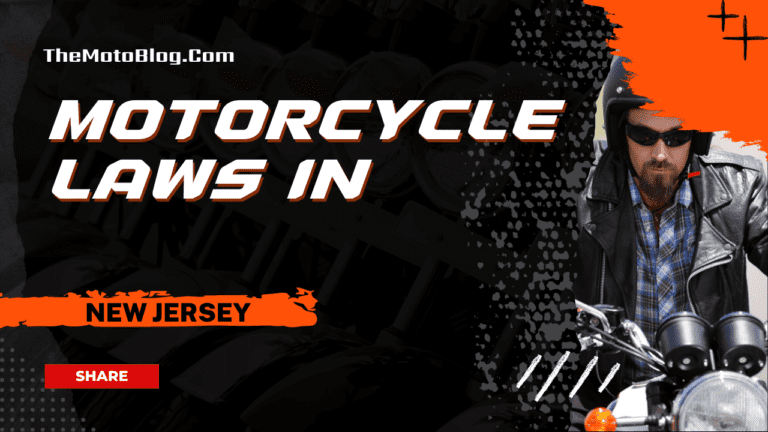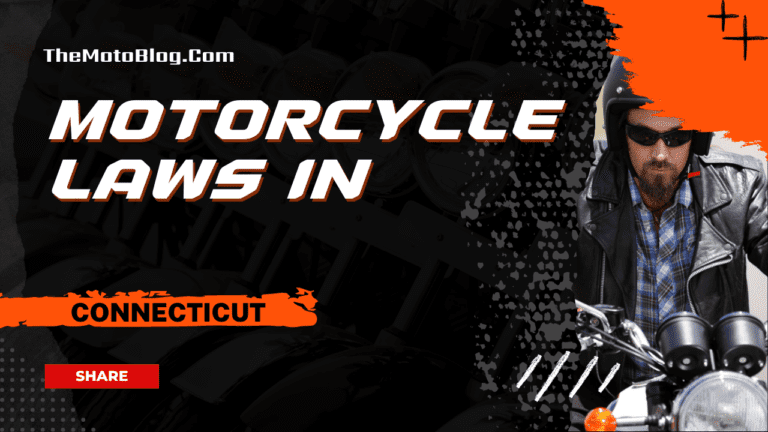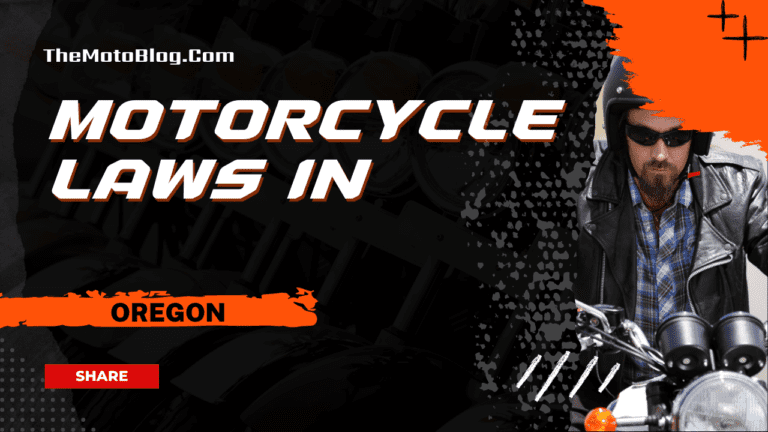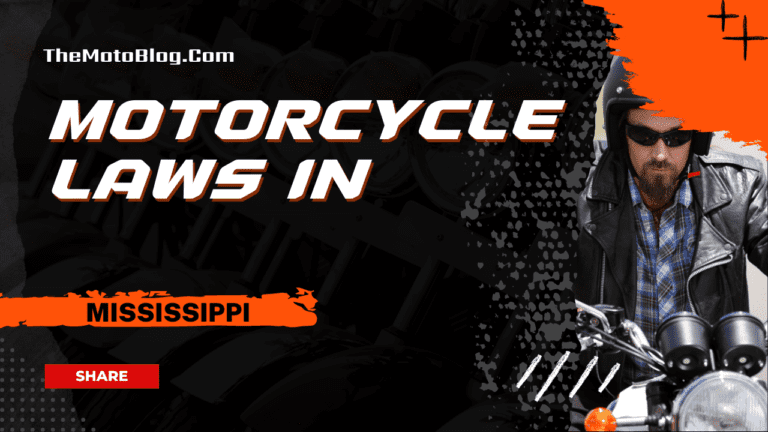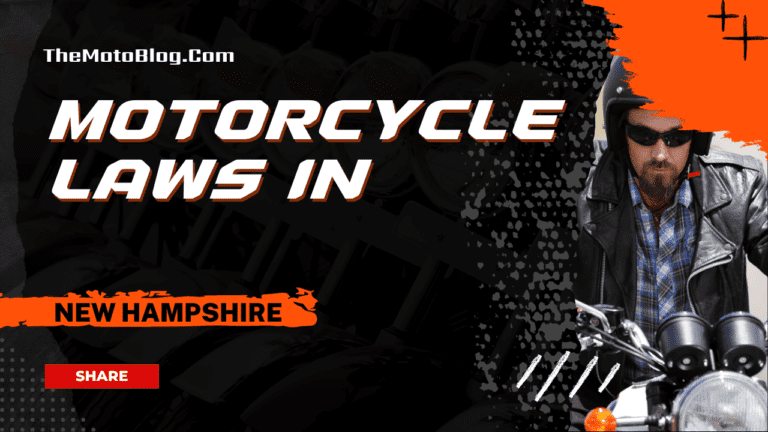Motorcycle Laws in Virginia: The Essential Guide for Riders
Let’s kickstart this by getting straight to the point: Motorcycle laws in Virginia are designed not only to regulate traffic but also to ensure the safety of riders and other road users. A thorough understanding of these rules is crucial for anyone who plans on hitting the open road on two wheels in this beautiful state.
Remember, being aware and conforming with local laws helps create safer roads for everyone involved.
Key Takeaways
- Motorcycle laws in Virginia are designed to regulate traffic and ensure the safety of all road users, including bikers.
- Virginia has a universal helmet law, requiring all riders to wear a helmet that meets or exceeds federal safety standards.
- In addition to helmets, motorcyclists in Virginia are required to use eye protection unless their motorcycle is equipped with a windshield.
- Lane splitting, or driving between two lanes of traffic, is prohibited in Virginia.
- Virginia requires motorcyclists to carry a minimum amount of liability insurance coverage, including $25,000 for bodily injury or death of one person, $50,000 for bodily injury or death of two or more people, and $20,000 for property damage.
- Motorcycle endorsements, which are permissions added to a driver’s license allowing them to operate motorcycles, are required and play a pivotal role in ensuring safety on the roads.
- Violating these motorcycle laws can lead to substantial penalties, including fines and suspension of driving privileges.
- Traffic control signals should be closely observed by motorcyclists in Virginia. For instance, bikers are allowed to treat non-responsive traffic light sensors after two rotations or two minutes of waiting as a malfunction, and cautiously proceed.
- Virginia’s motorcycle laws impact riders in multiple ways including equipment guidelines, helmet requirements, lane splitting bans, DUI rules, and insurance laws.
Motorcycle laws in Virginia are designed with an emphasis on safety and environmental considerations, including helmet requirements, exhaust noise level restrictions, and mandatory use of daytime headlights. Neighboring states each have their unique set of regulations. For example, motorcycle laws in West Virginia stipulate requirements for passenger footrests, while motorcycle laws in Maryland focus on learner’s permits and safety education. Moving further south, North Carolina’s motorcycle laws include provisions for periodic safety inspections, and Tennessee’s motorcycle laws have distinct regulations related to licensing and equipment. To the north, Kentucky’s motorcycle laws provide clear guidelines on helmet use and passenger age restrictions. Riders in Virginia and those traversing neighboring states should be familiar with these various laws to ensure legal compliance and safety as they travel across this diverse region.
Understanding Motorcycle Laws in Virginia
When you’re riding your motorcycle on the open roads of Virginia, it’s crucial to be aware of the laws that govern your ride. Virginia motorcycle laws are designed to keep every road user safe, and as a motorcyclist, adhering to these regulations is mandatory.
Virginia law mandates wearing a helmet at all times while riding. The state has a strict “universal helmet law”, meaning it applies to all riders regardless of age or experience level.
In addition to helmets, there are also requirements for eye protection in Virginia unless your motorcycle is equipped with a windshield.
Another important element related to safety equipment is the requirement for motorcycles to have both left and right side mirrors installed.
Moreover, lane splitting – driving between two lanes of traffic – isn’t allowed in Virginia.
Helmet Requirements: A Must in Virginia
I’ve been exploring motorcycle laws across the states, and I’ve found that Virginia is no exception when it comes to prioritizing rider safety. In this state, helmet use is not a choice; it’s a requirement. Let me break down what you need to know about helmet laws in Virginia.
The first thing you should know is that every motorcyclist and their passenger must wear protective helmets whenever they’re on the road. This law isn’t just for show – statistics from the National Highway Traffic Safety Administration (NHTSA) indicate that helmet usage significantly reduces the risk of fatal injuries.
| NHTSA Stats | Without Helmet | With Helmet |
|---|---|---|
| Fatal injury risk | 40% Higher | Standard |
Virginia doesn’t stop at just any helmet either. The state requires your gear to meet or exceed federal Department of Transportation (DOT) standards. So if you’re planning a ride, make sure your headgear has a sturdy chin strap and padding that can absorb impact efficiently.
In addition to these basics:
- Your helmet needs to be free from cracks or defects
- It should fit snugly without obstructing your view
- It must have reflective elements on both sides
Failure to comply with these regulations could lead to penalties and fines. But more importantly, it could increase your chance of serious injury if an accident occurs.
Lane Splitting: Is it Legal?
I’m diving straight into one of the most controversial topics among motorcyclists and drivers alike – lane splitting. If you’re not familiar with the term, lane splitting is when a motorcycle rides between lanes of stopped or slow-moving cars, usually in traffic jams.
As per Virginia law, this practice is currently illegal. It’s important to note that while some states allow or tolerate it (like California), many others don’t have specific laws addressing it either way.
Let me clarify why Virginia has outlawed lane splitting. The main reason is safety concerns. From a standpoint of traffic regulations, motorcycles are treated like any other vehicle on the road – they must follow similar rules as cars and trucks do. This means sticking to their assigned lanes without straddling or weaving through traffic.
Now, I know what you might be thinking – isn’t lane splitting faster and potentially safer for motorcyclists? While there are arguments favoring these points including:
- Reduces rear-end collisions for motorcycles
- Speeds up overall traffic flow
- Lessens congestion by freeing up space
The counter-arguments from authorities and safety experts primarily revolve around these concerns:
- Increases risk of side-swipe accidents
- Can startle unsuspecting car drivers
- Demands high level of riding skill
Despite ongoing debates on this issue nationally, legally speaking in Virginia – lane splitting remains prohibited. Motorcyclists caught doing so can face penalties which may include fines and points against their license.
For those advocating for change, remember that altering existing laws requires extensive research, safety assessments and legislative actions. Until then, if you’re cruising down the beautiful roads of Old Dominion State on your two wheels – stick firmly to your lane.
The Right Age to Ride a Motorcycle
Age plays a vital role when it comes to legally riding a motorcycle in Virginia. I’ve taken the time to thoroughly research and consolidate this information for you.
According to Virginia law, you must be at least 16 years and 3 months old to get your motorcycle license. This might seem young but there are stringent requirements that need to be met before getting behind those handlebars.
Firstly, prospective riders under the age of 19 must complete a state-approved driver education program. They’ll also have to hold their learner’s permit for nine months without any violations or infractions on their record. Lastly, they need parental consent, emphasizing the importance of family support in this decision.
| Age | Requirements |
|---|---|
| Under 19 | – State-approved driver education program <br> – Learner’s permit for nine months with no violations <br> – Parental consent |
Now let’s talk about adults over the age of 19. For these individuals, they can skip the driver’s education course but holding a learner’s permit for at least 60 days is compulsory. After fulfilling these requirements, they’re free to apply for their motorcycle license.
For folks aged between 50-75, it’s essential to renew their licenses every five years while riders above 75 years should do so annually.
Traffic Control Signals for Motorcyclists
Riding a motorcycle in Virginia can be thrilling, but it’s important to understand the state’s traffic control signals and how they apply to motorcyclists. This not only ensures your safety on the road, it also keeps you within the law.
Virginia has specific laws regarding traffic lights. If a motorcycle approaches an intersection with a steady red light, the rider must come to a complete stop. After stopping, if no other vehicles or pedestrians are approaching, and it’s safe to do so, the motorcyclist may proceed with caution through the intersection.
For turn signals, Virginia law requires that all motorcycles have operational turn signal devices. They should be used whenever turning or changing lanes to indicate your intentions to other drivers.
A unique consideration for motorcyclists is what happens when stoplight sensors don’t detect their presence? In Virginia, after two rotations of the traffic light without getting a green signal, or waiting for 2 minutes (whichever comes first), bikers are allowed by law to treat this as malfunctioning traffic control device and proceed cautiously through the intersection when it is clear.
Here are some key points summarised:
- Complete stop at steady red light
- Use turn indicators for lane changes and turns
- Treat undetected presence at stoplight as malfunction after waiting sufficiently
Remember these rules aren’t just guidelines – they’re enforceable laws designed with safety in mind. Adhering to them reduces your risk of accidents and penalties while enjoying your ride across Virginia’s picturesque roads.
The Role of Motorcycle Endorsements
Here in Virginia, motorcycle endorsements play a pivotal role in the world of motorcycling. They’re not just another piece of red tape, but an essential part of ensuring safety on the roads.
First up, let’s get one thing clear – what exactly is a motorcycle endorsement? Well, it’s essentially a permission added to your existing driver’s license that legally allows you to operate motorcycles. To earn this endorsement, you’ll have to pass both written and skills tests which are administered by the Department of Motor Vehicles (DMV).
Now I’m sure you’re wondering why these endorsements are so important. For starters, they ensure that all riders have at least basic knowledge about motorcycle operation and safety rules. This way we can reduce the risk of accidents caused by inexperienced or uneducated riders.
In Virginia specifically, if you’re under 19 years old and applying for a Class M designation (that’s Virginia DMV speak for a motorcycle endorsement), there’s an additional requirement. You must complete a state-approved motorcycle rider safety course.
Here’s some data on how many people actually follow through with getting their endorsements:
| Year | Number of Motorcycle Endorsements in Virginia |
|---|---|
| 2018 | 6,700 |
| 2019 | 7,200 |
| 2020 | 7,600 |
As you can see from my table above, it seems like more folks are starting to understand the significance and benefits these endorsements offer!
But that doesn’t mean everyone’s onboard yet. Ignoring this requirement could lead to serious consequences such as fines or even jail time. So remember – if you plan on riding your bike here in VA:
- Get your motorcycle endorsement
- Wear your helmet
- Follow traffic laws
Insurance Laws for Motorcycles in VA
Let’s delve into the nitty-gritty of motorcycle insurance laws in Virginia. The Old Dominion state requires all motorcyclists to carry a certain amount of liability insurance coverage. This isn’t just a suggestion, it’s the law.
The minimum coverage requirements are as follows:
- $25,000 for bodily injury or death of one person
- $50,000 for bodily injury or death of two or more people
- $20,000 for property damage
To put it simply, if you’re riding a motorcycle in VA, you’ve got to have these coverages at least. It’s important to know that these amounts are just the bare minimum and many riders choose to purchase additional coverage for extra protection.
Here’s a markdown table breaking down those numbers:
| Coverage Type | Minimum Required Coverage |
|---|---|
| Bodily Injury (One Person) | $25,000 |
| Bodily Injury (Two or More People) | $50,000 |
| Property Damage | $20,000 |
Now let’s talk about uninsured and underinsured motorist coverage. In Virginia, this is also required by law. You must carry at least:
- $25,000 per person / $50,000 per accident for uninsured/underinsured motorist bodily injury
- $20k uninsured/underinsured motorist property damage
This ensures that even if another driver causes an accident and they don’t have enough insurance – or any at all – you’re still covered.
Again here’s how it breaks down:
| Coverage Type | Minimum Required Coverage |
|---|---|
| Uninsured/Underinsured Motorist Bodily Injury | $25k per person / $50k per accident |
| Uninsured/Underinsured Motorist Property Damage | $20k |
Bear in mind these are minimum requirements – getting the right level of insurance should be based on your individual needs and circumstances. So while Virginia does require specific types of motorcycle insurance coverages with set minimum limits; remember it’s not always about meeting legal obligations but securing peace of mind when hitting the open road.
Penalties for Violating Motorcycle Laws
Skirting around the motorcycle laws in Virginia isn’t a wise move. The penalties can be substantial, and I’m not just talking about fines here. There’s a whole list of potential repercussions that you’ll want to avoid.
You see, if you’re caught riding without the proper helmet or eye protection (as required by state law), you’re looking at a fine of up to $250. It’s important to note this isn’t a one-time fee either. Each violation represents its own separate offense, so repeat violations can quickly add up.
| Violation | Penalty |
|---|---|
| Riding without Helmet/Eye Protection | Up to $250 |
That’s just the beginning though. If you choose to ride your motorcycle without the appropriate license, things get even more serious. You could face a fine of up to $2,500, spend up to 12 months in jail, or both! Again, each offense is considered separately.
| Violation | Penalty |
|---|---|
| Riding without License | Up to $2,500 and/or Jail Time (up to 12 months) |
But it doesn’t stop there folks! Virginia also has strict laws regarding motorcycle insurance. If you’re found operating a bike without sufficient coverage, expect another hefty penalty – this time we’re talking about a fine of up to $500, plus suspension of your driving privileges until proof of insurance is provided.
| Violation | Penalty |
|---|---|
| Riding without Insurance | Up to $500 + Suspension |
How These Laws Impact Virginia Riders
Being a motorcyclist in Virginia involves more than just enjoying the open road. It’s about knowing and understanding the laws that govern motorcycle use in this state. Each law has its impact, some subtle, others quite prominent.
One of the most significant laws is helmet requirement. In Virginia, all riders are required by law to wear helmets that meet or exceed federal safety standards. This isn’t just about safety; it’s also about legal compliance. Riding without a helmet could result in fines and penalties.
Virginia also enforces strict guidelines on equipment requirements for motorcycles. For instance:
- Motorcycles must have at least one mirror.
- They should be equipped with turn signal lights.
- The handlebars cannot be higher than 15 inches above the seat level.
Failing to comply with these rules can lead to hefty fines and points on your driving record.
Another factor unique to Virginian bikers is lane splitting – it’s illegal here. Unlike some states, you can’t ride between lanes of traffic or share a lane with another vehicle in Virginia.
It’s crucial also to remember that DUI laws apply as strictly to motorcyclists as they do to car drivers in Virginia. If you’re found riding under influence, severe consequences await including fines, license suspension, and even jail time depending on severity of infraction.
| Law | Impact |
|---|---|
| Helmet Requirement | Safety & Legal Compliance |
| Equipment Guidelines | Avoid Fines & Penalties |
| Lane Splitting Ban | Traffic Conformity |
| DUI Rules | Public Safety |
The ripple effects of these laws go far beyond keeping our roads safe: they shape how we experience our ride each day on Virginian roads.
Concluding Thoughts on Virginia’s Motorcycle Laws
I’ve spent considerable time dissecting the motorcycle laws in Virginia. It’s fair to say they’re extensive, designed with an emphasis on safety and not without their unique aspects.
One thing that stands out is the helmet law – it’s non-negotiable here. Everyone riding a motorcycle, be it a driver or passenger, absolutely must wear a helmet approved by the Department of Transportation. This isn’t just a suggestion; it’s mandatory under the law.
Eye protection is another crucial factor in Virginia’s legislation. If your bike doesn’t have windscreen, you’ll need to wear safety glasses or goggles. Again, this requirement underscores Virginia’s commitment to road safety for motorcyclists.
Let me also touch on insurance requirements in this state – they are pretty stringent too:
- $25,000 for bodily injury/death of one person
- $50,000 for bodily injury/death of two or more persons
- $20,000 for property damage
These figures aren’t arbitrary; they’re carefully calculated minimums set to ensure adequate coverage should an accident occur.
Another point worth noting is the exhaust noise limit that applies after 8 PM and before 8 AM – proof that Virginia takes its noise pollution seriously!
To sum up my insights from diving into these laws – if you’re planning on cruising around Old Dominion State atop two wheels anytime soon – make sure you’re well acquainted with all these regulations!
Motorcycle Laws in the US By States
If you liked this article, then please subscribe to our YouTube Channel for more Bike Videos. You can also find us on Instagram, Twitter and Facebook.
Disclosure: As an Amazon Associate, I earn from qualifying purchases. Read more about Amazon Affiliate Disclaimer.

Vishwanath Mathpati
I am Vishwanath Mathpati, a full-time Blogger and Motorcyclist from Bidar, Karnataka. I love writing about my Motorcycles Stories and Riding Gears on this blog.
Know More About Me.


